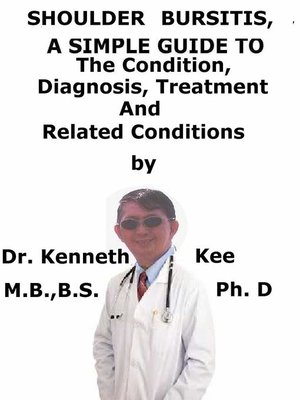Shoulder Bursitis, a Simple Guide to the Condition, Diagnosis, Treatment and Related Conditions
ebook
By Kenneth Kee

Sign up to save your library
With an OverDrive account, you can save your favorite libraries for at-a-glance information about availability. Find out more about OverDrive accounts.
Find this title in Libby, the library reading app by OverDrive.



Search for a digital library with this title
Title found at these libraries:
| Library Name | Distance |
|---|---|
| Loading... |
This book describes Shoulder Bursitis, Diagnosis and Treatment and Related Diseases
Shoulder bursitis is the most frequent cause of shoulder pain.
It occurs when one of the bursa, a small fluid-filled sac, becomes irritated and inflamed.
There is a number of different bursa (pleural bursae) around the shoulder that may be involved, but the most frequent is sub-acromial bursitis.
Pain is likely to develop slowly over time and may restrict movements where the patient lifts the arm above the head or behind the neck or back.
When treated promptly and effectively, symptoms will normally recover within a few weeks, but left untreated, symptoms slowly get worse and secondary disorders can develop.
A bursa is a tiny fluid-filled sac that comprises synovial cells that secrete lubricating fluid and functions as a gliding surface to decrease friction between tissues of the body.
There are 160 bursae in the body which are located between muscles, tendons and bones.
They supply cushioning and a smooth surface permitting the tissues to glide freely and fully as the person moves without any friction.
The major bursae are sited adjacent to the tendons near the large joints, such as the shoulders, elbows, hips, and knees.
There are a number of bursae sited around the shoulder joint such as the:
1. Sub-acromial bursa
2. Sub-scapular bursa
3. Sub-coracoid bursa
4. Cora-coclavicular bursa
5. Supra-acromial bursa
6. Sub-deltoid bursa (which tend to be connected)
Causes
When the bursa becomes irritated or injured, it reacts by producing more synovial fluid in an attempt to protect itself and the surrounding tissues which result in inflammation
This may be produced by:
1. Repetitive Friction
2. Injury
3. Underlying Disorder such as rheumatoid arthritis, gout or a bacterial infection
4. Surrounding Structures such as impingement or rotator cuff tendon tears
Activities that are frequent risk factors for shoulder bursitis are throwing a ball, lifting objects overhead, and trauma from a fall onto the shoulder.
People who are more likely to get bursitis are:
1. Carpenters
2. Musicians
3. Athletes
4. Gardeners
Symptoms:
Typical pain symptoms are:
a. Pain with certain shoulder movements
b. Pain at night that can awaken the patient from sleep
c. Shooting pains that extend down the outer edge of the arm
d. Discomfort when lying on the shoulder
e. Pain on the outside or top of the shoulder
f. Pain that gets worse when lifting the arm to the side
g. Pain when pushing on or opening a door
h. Pain when trying to circle the arm
j. Pressure and pain when pushing on the top of the shoulder
Other symptoms are:
Stiffness
Weakness
Diagnosis:
Shoulder bursitis is normally recognized by localized pain or swelling, tenderness of bursa, and pain with movement of the tissues in the involved area
Positive Neer impingement sign
Positive Hawkins test
Painful Arc Test
Yocum Test
Internal Impingement test
X-ray Findings
Frequent radiographic findings linked with impingement are:
a. Proximal migration of the humerus as observed in rotator cuff tear arthropathy
b. Traction osteophytes
c. Calcification of the coraco-acromial ligament
d. Cystic changes within the greater tuberosity
e. Type III-hooked acromion
MRI, Ultrasound and CT arthography all help to depict the inflamed bursa
Treatment
Shoulder bursitis treatment aims to:
1. Reduce pain and inflammation,
2. Prevent and correct any weakness and decreased movement at the...







